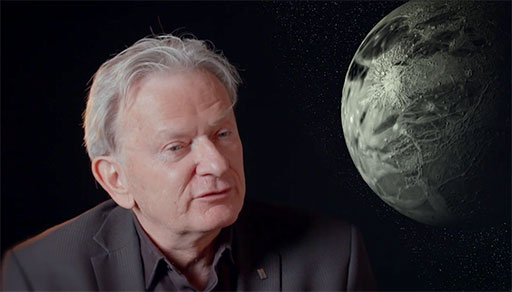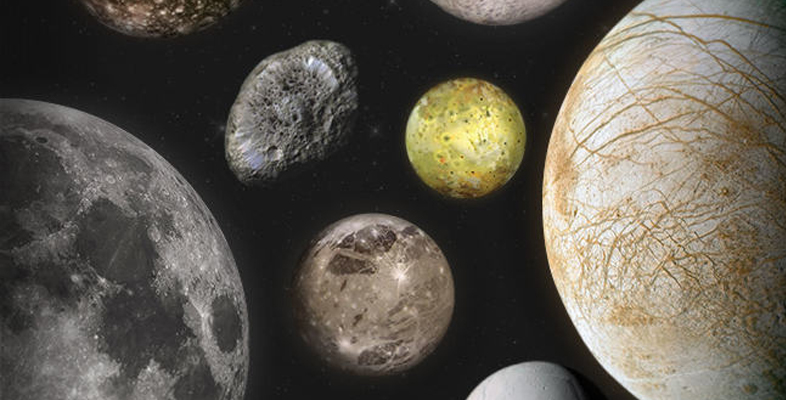1.4 JUICE and Europa Clipper
In this video, John Zarnecki discusses the advances in space instrumentation over the past few decades. Increased sensitivity, low size and low mass are key improvements.
The JUpiter ICy moons Explorer (JUICE) mission was launched by the European Space Agency (ESA) in April 2023. The spacecraft will arrive in orbit about Jupiter in July 2031. It will initially focus on Europa and Callisto and finally it will orbit Ganymede for several months to obtain detailed images of the surface from an altitude of just 200 km. The spacecraft will use flybys of Ganymede and Callisto to optimize the orbit. This will include flybys of Europa. Eventually it will be inserted into a highly elliptical orbit around Ganymede. The orbit will evolve to a 5000 km circular orbit, and will be lowered into a 500 km circular orbit. After mapping and other investigations at this altitude, it will lowered again to a 200 km circular orbit. The nominal mission ends after about 3 years, there is the possibility of an extension to the mission of 200 or more days.
Callisto, Europa and Ganymede are all suspected of having oceans below an icy surface, so ice-penetrating radar will be used, giving an indication of the character of the subsurface environment and whether liquid water really lies beneath. The scientific emphasis of the mission will be on trying to understand the habitability of each of these moons and the possibility of it hosting microbial life. Being so far away from the Sun is an irrelevance, given that tidal forces from Jupiter could provide the energy to melt the ice under the surface.
JUICE contains a suite of instruments including optical cameras, spectrometers, sub-millimetre wave instruments, laser altimeters and radar. Countries from around Europe have supplied different parts according to funding and expertise.
Work at the e2v centre for electronic imaging (CEI), based at the Open University campus in Milton Keynes is being done in preparation for the JANUS optical camera system. JANUS is designed to study global, regional and local morphology and processes on the moons and perform mapping of the clouds on Jupiter. The imaging detectors being used will need to withstand long-duration radiation damage from the space environment, particularly from charged particles concentrated by Jupiter’s magnetic field (which is one reason why JUICE will not spend any time close to Io, the innermost Galilean moon).
For more information on the work carried out at the centre for electronic imaging please follow this link [Tip: hold Ctrl and click a link to open it in a new tab. (Hide tip)] .
JUICE passed its ESA review and was approved for implementation in November 2014.

Transcript
In early 2014 NASA revived its interest in further exploration of Europa, as you can see at some of the links below, and in December 2015 Congress (in setting NASA’s future budget) directed that the Europa mission should include a lander. In fact NASA's next Europa mission, now officially named Europa Clipper will make about 45 close fly bys instead. It is due for launch in October 2024 for arrival in 2030. There is a large NASA website for Europa Clipper here.
See also:
- BBC news article on the JUICE mission - video. Juice team members Andrew Coates and Michele Dougherty discuss their ‘exciting’ Jupiter mission.
- ESA’s JUICE page. The offical JUICE page of the European Space Agency.
- David Rothery in conversation with Louise Prockter: Missions to Europa. A short bonus video recorded 10 September 2015, containing news of missions to Europa. You met Louise in a the ‘Ice and Ganymede’ video early in week 2. Since this bonus video was recorded, the mission has been further developed and has been named Europa Clipper. There is a link to the official mission page in Step 8.23.
- A Europa lander. Article about the 2015 US Congressional directive to include a lander as part of NASA’s Europa mission.
- NASA’s Europa mission. A 3 minute video about NASA’s Europa mission, published in June 2015.
- David Rothery in conversation again with Louise Prockter about missions to Europa A follow on from the September 2015 conversation, with up to date news.
- Simplified Europa lander proposed. A description of March 2018 plans for the Europa lander.
- Juno mission extended for Ganymede, Europa and Io flybys. NASA’s Juno spacecraft, in a polar orbit about Jupiter since 2016 has completed its primary mission (targeted especially at the magnetic field), and has been approved for a series of moons flybys in a extended mission. There will be a low-altitude flyby of Ganymede on 7 June 2021, reducing the orbital period from about 53 days to 43 days. That flyby sets up a close flyby of Europa on 29 Sept 2022, reducing the orbital period further to 38 days. A pair of close Io flybys, on 30 Dec 2023 and 3 Feb 2024 will reduce the orbital period to 33 days.
- NASA’s Juno mission. NASA Juno probe arrived in orbit about Jupiter in 2016. Its main goals were to study the magnetosphere and atmosphere of the planet, but in 2021 it began a series of fly-bys of Ganymede, Europa and Io. This link takes you to an image gallery.
